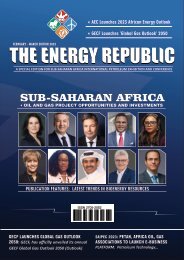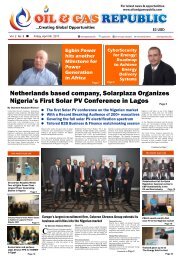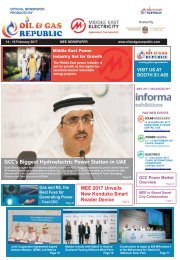The Energy Republic September Edition
This magazine is a Special Edition focused on the global energy transition agenda. We also did a spotlight on some countries and energy companies decarbonization strategy which will serve as a statistics to measure the ongoing progress and investment opportunities in energy transition. This particular’ edition, we featured Ukraine’s oil and gas potentials coupled with the just concluded Offshore Northern Seas (ONS) Conference 2022 held in Stavanger Norway, plus latest industry news in the Northsea and other regions as well.
This magazine is a Special Edition focused on the global energy transition agenda. We also
did a spotlight on some countries and energy companies decarbonization strategy which
will serve as a statistics to measure the ongoing progress and investment opportunities in
energy transition. This particular’ edition, we featured Ukraine’s oil and gas potentials
coupled with the just concluded Offshore Northern Seas (ONS) Conference 2022 held in
Stavanger Norway, plus latest industry news in the Northsea and other regions as well.
Create successful ePaper yourself
Turn your PDF publications into a flip-book with our unique Google optimized e-Paper software.
TOP STORIES
Anders Opedal, Chief Execu ve Officer (CEO) and President of Equinor
To accelerate to a climate-aligned energy
pathway requires a broad range of
government actions, including attention
to the financial architecture that can
accelerate direct investments in marketready
solutions and promote innovation
in early-stage technologies.
Oil and gas companies are adopting new
investment focus on renewables to meet
the needs of the global energy transition
agenda. Although, it will take different
forms, including commitments to reduce
emissions resulting from oil and gas
supply or to invest in new areas such as
offshore renewables.
In a statement made known to The
Energy Republic,
This investment has automatically
increased Equinor's share of gross CAPEX
for renewables and low carbon solutions
from around 4% in 2020 to more than
50% by 2030. As part of the company's
strategy to become a leading global
energy player, Equinor has also set a
target to install a total of 12-16 GW of
renewable energy capacity by 2030 -
which is more than twice the total global
offshore wind capacity installed in 2020.
Equinor’s net carbon intensity and netzero
ambitions organic capital
expenditures of 10 billion USD for 2022-2023
and 12 billion USD for 2023-2024 will result
from an increasing share of renewable
investments, which are expected to total 23
billion USD in the period 2021-2026. Our
capital allocation to renewables and low
carbon solutions will accelerate towards
2030. From the company's share of 4% of
annual gross CAPEX in 2020, renewables and
low carbon investments are expected to
grow to above 30% of annual gross CAPEX by
2025 and over 50% of annual gross CAPEX by
2030 - which is aligned with the goals of the
Paris Agreement and the Norwegian state’s
ambition for emission reductions from the
oil and gas industry.
The company disclosed that in 2021, it
developed a separate reporting segment for
its renewables unit to recognize its strategic
importance and materiality. In 2021, capital
gains from renewables were 1.4 billion USD, a
more than seven-fold increase from 2020,
resulting primarily from profitable asset farmdowns.
“ “
Equinor is investing
about $23 billion in
capital expenditure
(CAPEX) for offshore
wind projects over the
next five years (2021 -
2026).
Speaking on this development, Equinor's
CEO, Anders Opedal explained: "We are
accelerating the transition and setting an
ambition to reach a 40% reduction in net
carbon intensity by 2035, on the way towards
net zero by 2050.
“We are stepping up investments in
renewables and low carbon solutions to more
than 50% of gross annual investments by
2030; Growing cash flow and returns,
expecting a free cash flow of around USD 35
billion(3) before capital distribution in 2021 –
2026 and around 12% return on average
capital employed(2) in 2021 – 2030;
Increasing the quarterly cash dividend to 18
cents per share and introducing new share
buy-back programme.
“Our strategy is backed up by clear actions to
accelerate our transition while growing cash
flow and returns.
“
We are optimizing our
oil and gas portfolio to
deliver even stronger
cash flow and returns
with reduced emissions
from production, and
we expect significant
profitable growth within
renewables and low
carbon solutions. This is
a strategy to create
value as a leader in the
energy transition.
“This is a business strategy to ensure longterm
competitiveness during a period with
profound changes in the energy systems, as
society moves towards net zero. We are
building on our position as a global leader in
carbon-efficient production of oil and gas. We
will continue to cut emissions, and in the
longer term, Equinor expects to produce less
oil and gas than today recognizing reducing
demand. Significant growth within
renewables and low carbon solutions will
increase the pace of change towards 2030
and 2035.”
Equinor has divested
assets worth USD$2.3
billion, booked a capital
gain of USD 1.7 billion,
and expects to deliver
nominal equity returns
in the range of 12% –
16% from the offshore
wind projects with
offtake contracts in the
UK and US.
Project Opportunities
The project opportunities listed in Equinor’s
energy transition plan include Empire Wind
and Beacon Wind in the United States,
Doggerbank in the UK, and its projects
offshore Poland, which contribute two-thirds
to the company's goal of 12 to 16 GW by 2030,
with real returns of 4% to 8%.
57
THE ENERGY REPUBLIC I SPECIAL EDITION















